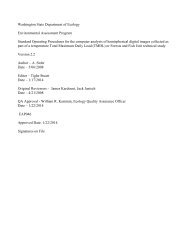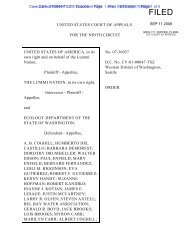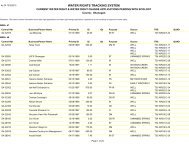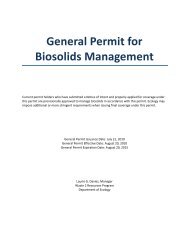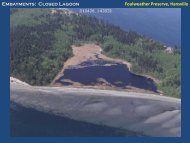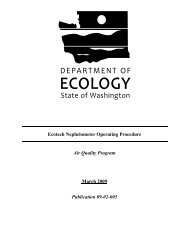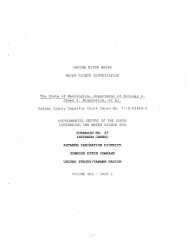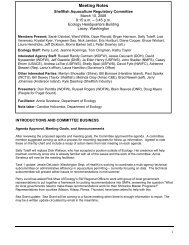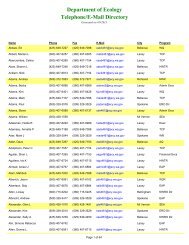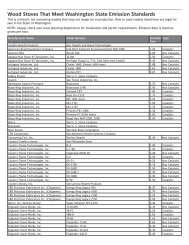WRIA 62 WMP 032305 - Washington State Department of Ecology
WRIA 62 WMP 032305 - Washington State Department of Ecology
WRIA 62 WMP 032305 - Washington State Department of Ecology
Create successful ePaper yourself
Turn your PDF publications into a flip-book with our unique Google optimized e-Paper software.
March, 2005 -<strong>62</strong>- 023-1289-003.3040<br />
The Watershed Planning Unit feels it is important that the <strong>Washington</strong> <strong>State</strong> <strong>Department</strong> <strong>of</strong> <strong>Ecology</strong>,<br />
the Idaho <strong>Department</strong> <strong>of</strong> Environmental Quality and the Kalispel Tribe, all assisted by EPA,<br />
coordinate the development <strong>of</strong> the TMDLs for the Pend Oreille River, particularly at the technical<br />
assessment phase. For example, the Watershed Planning Unit feels it is important that natural<br />
temperature conditions are identified correctly (through modeling) and that this is done for the upper<br />
watershed in Idaho (Lake Pend Oreille and the Pend Oreille River in Idaho) before modeling efforts<br />
are conducted for the lower Pend Oreille River in <strong>Washington</strong>. Only after natural temperature<br />
conditions are understood should <strong>Ecology</strong> and the Idaho <strong>Department</strong> <strong>of</strong> Environmental Quality try to<br />
quantify any potential increases due to projects in Idaho and <strong>Washington</strong>. The efforts to understand<br />
natural temperature conditions will determine whether or not the Pend Oreille River temperatures are<br />
truly an impairment or if some (or all) <strong>of</strong> the elevated temperatures are due to natural conditions. The<br />
Planning Unit has emphasized the need for coordination in letters sent to EPA, <strong>Ecology</strong> and IDEQ on<br />
February 2, 2005. A copy <strong>of</strong> these letters are included in Appendix H.<br />
<strong>Ecology</strong> held the initial TMDL public meeting, in Newport, in January, 2005. At this meeting,<br />
<strong>Ecology</strong> explained the overall TMDL process, presented the study plans (i.e., the TDG and<br />
temperature QAPPs) and solicited questions and concerns from those present. The Kalispel Tribe<br />
explained the Tribe’s involvement. The Tri-<strong>State</strong> Water Quality Council asked those present to sign<br />
up to be contacted about upcoming meetings and development <strong>of</strong> a stakeholder advisory group. The<br />
<strong>WRIA</strong> <strong>62</strong> Watershed Planning Implementing Body can provide input to the TMDLs by becoming<br />
involved with this advisory group. The Tri-<strong>State</strong> Water Quality Council will be facilitating and<br />
coordinating this stakeholder advisory group.<br />
In addition to the ongoing TDG and temperature TMDLs for the Pend Oreille River mainstem in<br />
<strong>WRIA</strong> <strong>62</strong>, the Pend Oreille River is being assessed to determine whether or not it should remain on<br />
the 303(d) list for Aldrin in fish tissue (<strong>Ecology</strong>, 2004d). Aldrin (a toxic chemical) will be analyzed<br />
in fish tissue and the results compared to the criteria specified by <strong>Ecology</strong>’s Water Quality 303(d)<br />
Listing Policy. The QAPP for the assessment (http://www.ecy.wa.gov/biblio/0403115.html) was<br />
completed in October 2004 and the sampling in November 2004. The final report is due in May<br />
2005.<br />
4.2.5 WQUAL-4a Background and Rationale<br />
Problem <strong>State</strong>ment: The natural quality <strong>of</strong> drinking water provided to some communities does<br />
not meet <strong>Washington</strong> <strong>State</strong> secondary drinking water standards.<br />
Within Section 3.8.2 <strong>of</strong> the Phase II, Level 2 Technical Assessment (Golder, 2005) information is<br />
presented on groundwater quality within the Kalispel Reservation, groundwater supplied to the Town<br />
<strong>of</strong> Ione and an assessment is made <strong>of</strong> the groundwater quality for public water systems in <strong>WRIA</strong> <strong>62</strong><br />
based on information contained within the WDOH water quality database. The findings <strong>of</strong> the<br />
assessment are that groundwater quality is generally good in <strong>WRIA</strong> <strong>62</strong> with little evidence <strong>of</strong> human<br />
related impacts to groundwater quality. However, high levels <strong>of</strong> hardness, iron and manganese (due<br />
to natural geochemical processes) are common in <strong>WRIA</strong> <strong>62</strong> groundwater and have been detected in<br />
wells completed in the unconsolidated and consolidated sediments, and in bedrock. Elevated<br />
hardness causes scale on the inside <strong>of</strong> pipes and boilers. If groundwater containing dissolved iron and<br />
manganese (from a reducing environment) is exposed to the atmosphere, the iron and manganese in<br />
solution is oxidized to a less soluble form and precipitates as an oxide or carbonate. Iron and<br />
manganese oxides and carbonates can clog well screens and water distribution piping, can cause taste<br />
<strong>WRIA</strong> <strong>62</strong> <strong>WMP</strong> <strong>032305</strong>



